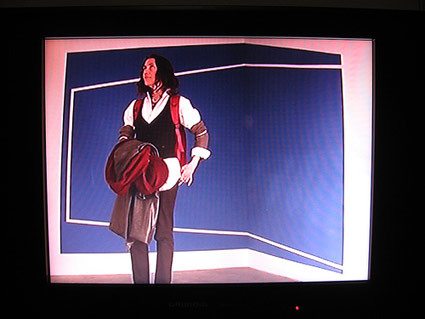
Five Years, London
'Huis Clos' 1 April 2007
Five Years, 'Huis Clos'
It can be said that Louisa Minkin’s ‘Huis Clos’ is a work, in the active sense, that it is still at work despite its exhibition having already taken place.
Huis Clos has three stages:An event is videoed. Across the corner of a room a rectilinear shape has been masked. Into the left of the frame enters a figure who is entirely clothed in a skin-tight blue screen suit, even covering the head, the feet and the hands of the person. The figure starts a compressor, takes up a spray gun and sprays blue the masked out shape. The blue is identical to the blue of suit of the shape’s maker. As blue takes hold of the shape the figure begins to correspond to its emerging surrounding.
In the room the blue shape has been unmasked. It is clear now that the shape has another, open rectilinear shape within it. There is also the sense that these shapes are anamorphic , that they take on distinct qualities when viewed from a particular position. The room now has become a gallery, people are viewing the work but the work exhibited is not only the blue wall painting.
Two flat screen monitors are also present. One shows the video of the blue shapes making, the other shows a live feed of the image of the gallery visitors, framed, within the blue shape and, in turn, the screen of the monitor.
The third phase is the projects documentation, as video, photo and text.
These phases are not simply steps along the way to staging the spectator as subject.
The screen suit and the blue shape can be read as an absorptive structure. As Minkin says in Huis Clos’ accompanying text
“The actions of the blue figure are the opposite of camouflage, rather than adapt to its back ground, it alters its background in order to naturalise itself..”
whether this act is one where the blue figure ‘naturalise(s) itself’ is perhaps debatable but perhaps the question that arises is rather one of an identification and a merging of figure and ground in the blue shape’s making which in turn brings into focus such things as the death of the author and the monochrome as forms of both the maker and the cultural form. This figure/ground relationship is then displaced through the blue shape wall painting exhibition. Here is shown both the wall painting’s production and what it produces through its exhibition and its reconfiguration via the live feed. There is a sense here that the literal topos of the space is one of a passage between the making and the reception that in turn is subject to an immanent quality of the stages combined as a working of the ground and as a series of displacements, reversals (and situations).The framing of the gallery visitor fore-grounded before the blue shape places them in sharp contrast, differentiated from the ground, which in turn is in sharp contrast to the assimilation of figure/maker and ground in the works initial phase. The realm of the pictorial is what is felt to be at work here. The creation of a structure that differentiates, distinguishes and positions where as in its inception it assimilates, maybe even estranges itself; merges with its actions. The potential of the productive logic of this work is heightened by the fact that the screen suit and the blue ground can be used to key in other grounds. The blue screen’s maker can disappear or repeat itself. The beholder in the final phase can be keyed in with alternative grounds. The displacements and divisions at work here seem to endlessly fold in on themselves as one moves between the re-transcriptions; the role of the blue shape is transformed according to the agency of the figure and the relationship to medium. The result seems to be a complex object where contexts of production, reception and the consumption of the piece ‘as’ image transform familiar ideas of figure and ground as facedness or absorption and theatricality into a kaleidoscope of relations, endlessly turning.
James Pinson

